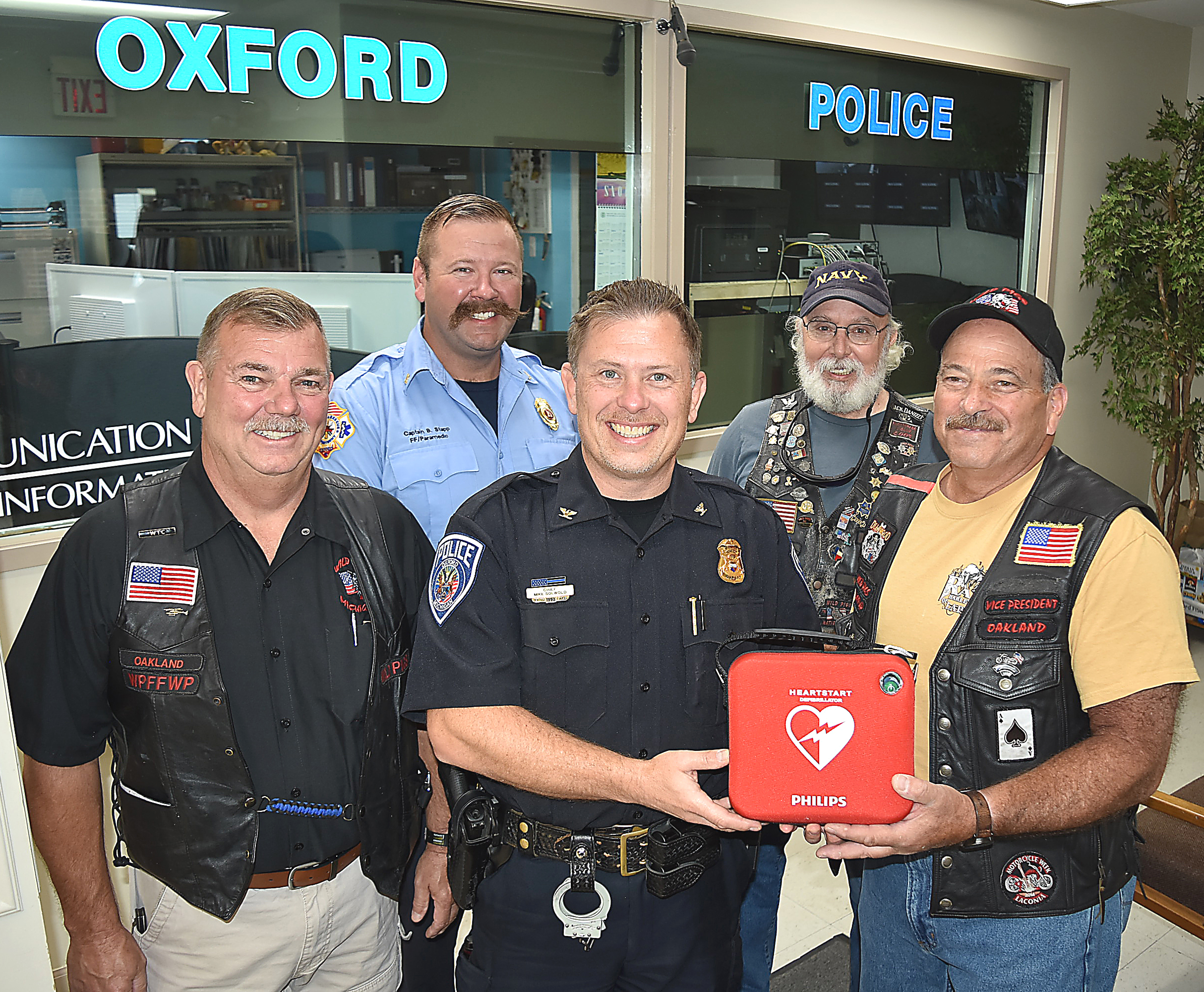
Thanks to some fellas with a passion for two wheels and the open road, the Oxford Village Police Department has a new piece of lifesaving equipment.
Three representatives of the Wild Pigs Motorcycle Club, a group of current and retired police officers whose mission is to support law enforcement, visited the station Aug. 1 to donate an automated external defibrillator (AED).
“We’ve given a lot of these out,” said Mark Soffin, vice president of Wild Pigs’ Oakland Michigan Chapter and a retired officer who spent 25 years with the Michigan State Police.
The chapter has donated AEDs to the Lapeer County Sheriff’s Office and the police departments in Gaines Township, Brown City, Imlay City and Mayville.
“I appreciate what these guys do,” said village Police Chief Mike Solwold. “They go around and help agencies that have a need for these things. We’re going to take full advantage of that.”
“I’ll never turn down equipment, especially a defibrillator,” Solwold continued. “This (donation) will (ensure) we have a defibrillator now in every car and inside the station.”
An AED is a lightweight, portable device that sends an electric shock to the heart in an attempt to stop irregular beating and enable a normal rhythm to resume after sudden cardiac arrest.
According to the American Heart Association (AHA), if sudden cardiac arrest, which occurs when the heart malfunctions and stops beating unexpectedly, is “not treated within minutes, it quickly leads to death.”
“The heart must be ‘defibrillated’ quickly because a victim’s chance of surviving drops by seven to 10 percent for every minute a normal beat isn’t restored,” the AHA states.
The AHA also notes that nine in 10 cardiac arrest victims who receive a shock from an AED in the first minute live.
In the event of a medical emergency, Solwold said “seconds count” and he wants his officers to have all the equipment necessary to begin taking lifesaving measures should they arrive on scene before the fire department.
“You just never know when you’re going to need (a defibrillator),” said the chief, noting it could be used on a citizen, a suspect in custody or even a fellow officer.
“It’s a great asset to have,” Solwold said.
Soffin agreed. He said “there’s nothing worse” for a police officer than to arrive at a scene and find “he isn’t equipped to do anything.”
Soffin applauded Solwold for being a “progressive police chief” who “recognizes the value” of equipping his agency with these devices.
“There are some agencies in Michigan that don’t want to carry (AEDs),” he said.
Some law enforcement agencies, particularly smaller departments, are “not comfortable” using them, Soffin explained. This doesn’t make sense to him as they’re “the ones that probably need them the most” because they’re generally located in more rural areas where the response times for emergency medical services are longer.
Other departments, according to Soffin, have the “general attitude” that administering emergency medical care is something for firefighters, paramedics and emergency medical technicians to do, not cops.
“They don’t really think it’s their job,” he said. “It’s frustrating.”
Soffin believes all police vehicles in Michigan should be mandated to carry AEDs.
“It’s just the natural progression from first aid kits, really,” he said.
Although formal training is recommended by the AHA to use these devices, it’s not required. Oxford Fire Capt. B.J. Stapp said an AED is so easy to use that anyone can do it.
“All you have to do is turn it on and it walks you through every step,” he said.
Once adhesive electrodes are attached to a victim, the AED’s built-in computer determines whether defibrillation is needed. If it is, the person using the AED is directed, by a recorded voice, to press the shock button. Voice prompts guide the AED user through the entire process.
“You just have to follow its directions,” Stapp said. “The key thing is just encouraging people to turn it on and use it because that’s going to make the big difference.”
Stapp noted people shouldn’t be afraid to use an AED because they’re worried about potentially harming someone. He explained this device will not direct you or allow you to shock a person who doesn’t have an abnormal heart beat requiring it.
“You won’t hurt somebody using (an) AED,” the captain said. “You could never put it on somebody and cause them harm.”
According to the AHA, “Some studies have shown that 90 percent of the time AEDs are able to detect a rhythm that should be defibrillated. This data suggests that AEDs are highly effective in detecting when (or when not) to deliver a shock.”
Soffin noted the Wild Pigs are grateful to Stapp because he used his “expertise” to help the club start purchasing better AEDs for a lower price, “which means we can buy more.”
The club was previously paying between $1,600 and $1,700 for AEDs. Now, it’s getting them for approximately $1,300.
“Within days, he had us set up,” Soffin said.

Leave a Reply